Foot problems and diabetes seem to go hand in hand because foot problems are common among people with diabetes. Although you constantly monitor your blood glucose, you find that you always seem to have painful or swollen feet.
Consulting your healthcare provider is always recommended. This article provides information about the causes of foot problems in diabetics.
Paying closer attention to your feet, for starters, is really important. However, as a diabetic, there are things you can do to help prevent foot problems or manage them when they do happen.
Table of Contents
Why Must I Pay Closer Attention to My Feet?
The answer to this question is simple.
Diabetes can be dangerous to your feet—even a small cut can produce serious consequences such as causing nerve damage resulting in a lack of feeling in your feet.
It may also reduce blood flow to the feet. Poor circulation can cause sores on the feet to heal more slowly, making it harder to heal an injury or resist infection.
Another consequence is that because diabetes can affect both circulation and your nerves, you may not notice a foreign object in your shoe (small piece of stone, wood or glass) which could eventually develop into a blister or sore.
This could lead to an infection or a non healing wound that could eventually lead to serious complications and put you at risk for an amputation.
Foot Problems and Diabetes – Tips for Healthy Feet
- Elevate your legs while sitting.
- Don’t sit with your legs crossed.
- Don’t sit for long periods of time; get up and move around every once in a while.
- Wiggle your toes and move your ankles for a few minutes several times a day to improve your circulation.
- Don’t wear anything tight around your legs, such as tight socks or knee-highs.
- If your feet get cold at night, wear socks. Do not warm them with a heating pad or hot water bottle.
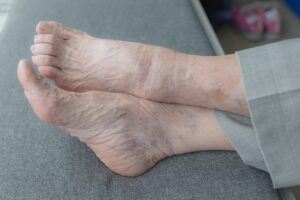
How Do I Get Started?
The first step is to follow a daily foot care routine. Start by putting together a foot care kit.
Your kit should include nail clippers, a nail file, moisturizing lotion, and a non-breakable hand mirror.
Of course, you must create time for the routine AND adhere to it.
Once you have your kit, you are ready to set up your routine. Diabetes Canada (2014) and ACFA (2020) offer lots of advice on how to do this:
- Check your feet carefully, including between your toes. Look for any problems such as cuts, cracks, or ingrown toenails. Use the hand mirror to see the bottom of your feet, or ask someone to check them for you.
- Trim your nails straight across (not rounded down at the corners) and file down any sharp edges. Use specialty clippers for seniors with diabetes or arthritis
- Clean any cuts or scratches with mild soap and water and cover them with a dry dressing designed for sensitive skin.
- Wash your feet with warm (not hot) water and a mild soap. Do not soak your feet, because this can cause skin to dry out.
- Dry your feet carefully, especially between your toes.
- Apply moisturizing lotion to your heels and soles and wipe off any extra that is not absorbed into your skin. Do not put lotion between your toes, because too much moisture may lead to a fungal infection.
For more information on foot care routine, check out this useful article from the American College of Foot and Ankle Surgeons – Diabetic Foot Care Guidelines
Next…. Are You Wearing the Right Kind of Shoes?
CONDUCT A CHECK


Look down at your feet and carefully check your shoes. Do you see or note any of the following?
- The shoe rubs or pinches? If this is true – you shouldn’t really be wearing these shoes anyway! Throw them out as the discomfort and other possible foot problems you are causing yourself are not worth it.
- The lining of the shoe is torn. Why are you wearing these shoes?
- The mid-portion of the shoe is worn down. Again, why are you wearing these shoes?
- The heel has started to wear down on one side. No wonder you have foot pain! Refer to this previous article Foot Pain in Seniors – Can Be Agonizing
FEET PROBLEMS AND DIABETES MANAGEMENT – REPLACE YOUR SHOES
If your answer to any of these questions is “Yes”, then it is time to replace your shoes.
While there is no single type of shoe that is the best for anyone with diabetes, there are several things to look for which make some shoes better choices.
Some shoes are specially labelled as designed for diabetics while shoes with removable footbeds to accommodate custom orthotics can help with swollen feet.
Check out another previous article – Best Shoes for Seniors – Selection Tips. View some popular, comfortable diabetic shoes for men and women below. CLICK on the images for additional information and price.
Propet Women’s Tour Walker Medicare/HCPCS Code A5500
Diabetic Shoe
- Leather, with rubber sole and removable footbed
- Medicare/HCPCS code A5500 diabetic shoe
- Closure is hook and loop
- 6 color choices – Sport White, White, Black, White/Berry, White/Blue, White 1
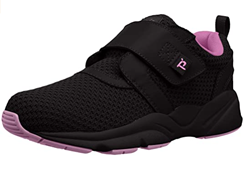

Propet Women’s Stability X Strap Sneaker
- Mesh upper with brushed-nylon lining and padded collar and tongue. Man made rubber sole
- Two removable footbed to accommodate custom orthotics
- Adjustable hook and strap closure
- 3 colors – Light grey, Black Berry, Black
Propet Men’s M5015
- Leather with man made sole. PU unit sole provides cushion, traction and durable wear
- Medicare/HCPCS code A5500 diabetic shoe
- Strap closure
- 4 colors – Black Grain, Dark Brown Grain, Black, Dark Brown
Propet Men’s Life Walker Strap Sneaker
- Leather
- Rubber sole
- Rocker profile
- Padded collar and tongue
- Adjustable hook-and-loop closure
- Removable cushioned orthotic
- 4 colors – Black, Sport White, White 1, White 2
ADDITIONAL CONSIDERATIONS FOR FOOT PAIN AND DIABETES
- Did you know that your feet change over time as you grow older? This is why it is best practice to always have your feet measured when you buy new shoes.
- Whenever going to buy new shoes, always wear the type of socks you will be wearing most frequently with these specific shoes to test them out. When buying socks, only select diabetic socks because they are breathable and do not restrict blood circulation. These should be worn at all times and come in different colors for men and women.
- Did you also know that your feet generally tend to swell as the day progresses? So, always shop for shoes later in the day, because if you shop in the morning, you may find that the shoes may be too tight for you. I have personally experienced this and, believe me, it is such an inconvenience to have to go back to the store to make a return or exchange.
FOOT PROBLEMS AND DIABETES MANAGEMENT – MAINTAIN GOOD CIRCULATION
Diabetics need to maintain good circulation in the legs and feet, hence require socks that are breathable and less compressing than regular socks. This is also good for your heart health.
There are several options available for purchase. Some examples are provided below.
Yomandamor 6 Pairs Men’s Bamboo Seamless Non-binding Ankle Diabetic Socks
- 70% bamboo + 30% elastane material for the finest fit and comfort;
- Seamless toe with non irritating smooth toe seam.
- Lightweight – suits all seasons
- Large wide calf and top with micromesh and breathing hole: the sock can breathe and discharge the sweat perfectly; Very stretchy
- Non-binding top reduces the risk of infection, foot pressure and blistering which is better for circulation
- 4 colors available
Yomandmor 5 Pairs Women’s Cotton Ankle Breathable Mesh Diabetic Socks
- 80% Combed Cotton, 20% Elastane
- The cotton dress socks provides soothing comfort for pregnant women, the elderly, and those with wider feet.
- Breathable cotton is characterized by good moisture absorption and easy to clean and dry when compared with ordinary cotton yarn.
- Color – White
Foot Problems and Diabetes – Warning Signs
There are some warning signs that should never be ignored.
If you experience any of the following, please see your doctor immediately as they may indicate other underlying conditions:
- One foot looks different from the other foot
- The skin on your feet is dry, callused, or cracked
- One or both feet change shape.
- Sores or blisters have developed on your feet
- Both your feet feel like blocks of wood and you experience difficulty lifting them up.
- Your feet experience numbness, pain, or tingling
Recommendations


The most important recommendations are the following:
As a senior with diabetes, NEVER try to treat your own foot problems or use over-the-counter foot creams or removers.
This means that you must get your doctor, healthcare professional, foot care specialist to treat even common problems such as corns, calluses, ingrown toenails, warts, or entry of a foreign object in the foot whether large, small or minute (a sliver).
Have your feet checked by your doctor or healthcare professional at least once a year as they will screen for nerve damage and loss of circulation so that appropriate action can very quickly be taken.
OTHER TIPS
- Always shake out your shoes and feel the inside before wearing them.
- Wear fresh, clean socks every day. When possible, wear white socks, because if you have a cut or sore it will be easier to see any blood or other outflow. It is recommended that you wear socks specifically made for diabetics. These socks have extra cushioning, do not have elastic tops, are higher than the ankle and are made from fibers that wick moisture away from the skin.
- Wear socks to bed if your feet get cold at night, but NEVER use a heating pad or a hot water bottle.
- Keep your feet warm and dry. Don’t let your feet get wet in snow or rain and wear warm socks and shoes in winter.
- Never walk barefoot. Not even at home! Always wear shoes or slippers. You could step on something and get a scratch or cut.
Do you know of any other useful recommendations that we can add to this list of Foot problems and Diabetes? Share with us in the comment box below.
Related Article
- Shoes for Diabetics – How to Choose
- Poor Circulation Problems in Seniors – The Real Dangers
- The Causes of Poor Blood Circulation in Aging Adults
- Compression Leg Socks – How to Buy and Select
- The Best Products that Can Help Improve Poor Blood Circulation
References
National Institute of Diabetes and Digestive and Kidney Diseases. Diabetes and Foot Problems https://www.niddk.nih.gov/health-information/diabetes/overview/preventing-problems/foot-problems
American Diabetes Association. Microvascular complications and foot care. Diabetes Care. 2016;39(Suppl. 1):S78.
American College of Foot and Ankle Surgeons (ACFS) (2020) – Diabetic Foot Care Guidelines



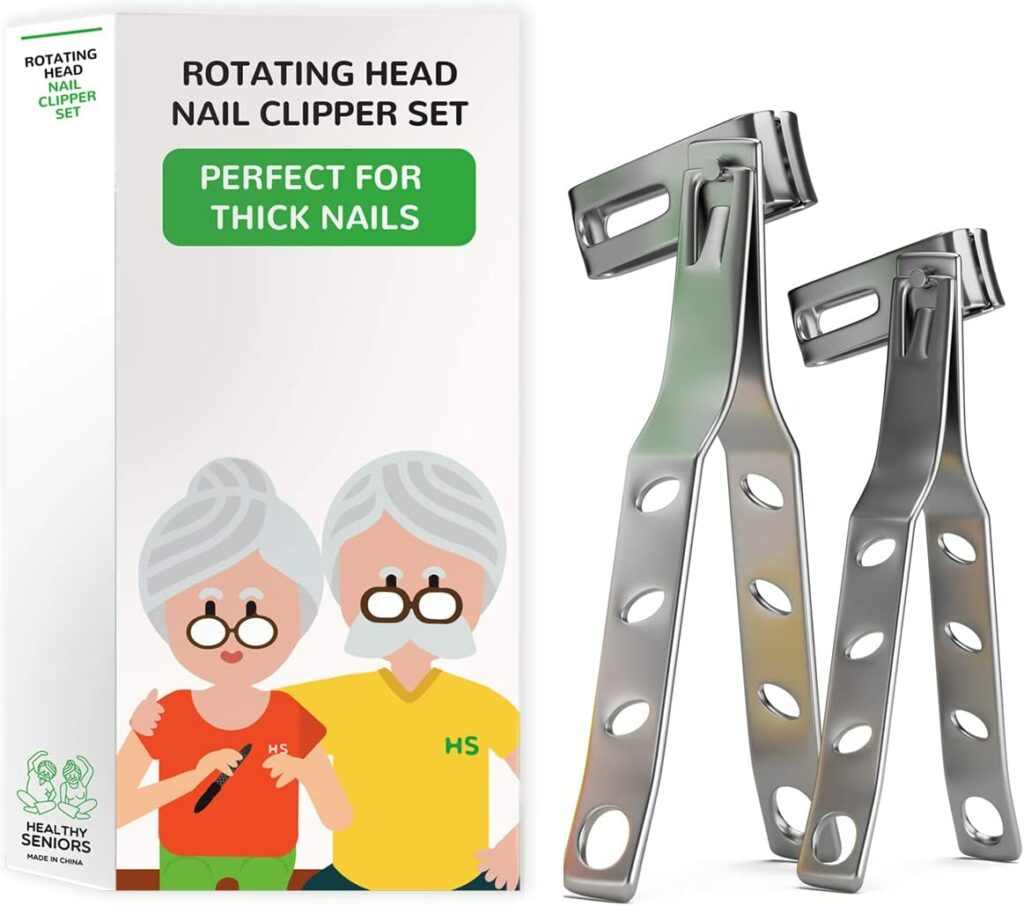
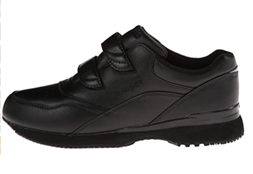
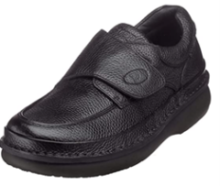
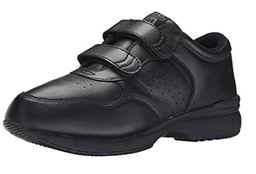

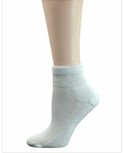
Great and informative article on foot problems and diabetes care. I will share with my family member that has diabetes. It’s so important for seniors to care of themselves and know what to look for. The list of warning signs and other tips are so helpful! Should this care be done by a foot doctor or just a regular family doctor?
Hi Alyse, it is always preferable to visit your regular family doctor first for discussion and examination. If necessary, your GP may then refer you to a foot doctor.
Thankfully there are posts like this one where I can find all the information about diabetes and other related problems. I just wanted to say thanks for sharing. I found a lot of useful information here that I’ll be definitely applying in my own life. My grandmother has had a sever diabetes condition. However, she was a rare case in our family. In any case, I like to stay informed on these topics, so once again, thanks for sharing these insights.
Knowledge, they say, is power Ivan. It’s always better to stay ahead of the aging process to avoid surprises! Thanks for visiting.
Ceci
Wow thank you for this important information! I used to be in the Army and running every morning and marching quite often really can take its toll on your feet! These are some really great tips!
The only thing I could add is to use Merino wool for hiking socks as it is really good for both winter and summer and super comfy for your feet on a long nature hike!
Thanks for the info about Merino wool. I just might come up with an article on it in the near future! Stay tuned.
Ceci
Hi Ceci,
This is a good article. I actually wished I could have seen this when my father was alive. He had diabetes and really bad feet and legs. His doctors were always concerned with how his feet and legs looked so they kept a close eye on him. His father, my grandfather, ended up getting gangrene in his legs and they had to amputate. As a kid, it was really hard to watch him lose his feet, then up to his knee, then up to his thigh and then to the next leg the same thing. The infection was always growing and always there.
Unfortunately for my grandfather, he didn’t take care of his diabetes though. He would eat an entire pack of oreos every night even though he wasn’t supposed to. I thought the same fate would happen to my Dad since he was the same as his father. Still eating sweets every night and his feet and legs always getting worse.
Great article, and great information.
Thanks!
Katrina
Hi Katrina, sorry that this article could not benefit your father. Hopefully, there will be others out there who will be able to read it and derive benefit from it.
Ceci
Hello again!
Just like my comment at https://metamorphosishub.com/the-causes-of-osteoporosis-my-risks/#more-958, I have a bit of experience with this as well. My dad’s friend married a man with diabetes and it affected his life terribly.
He lost sight in one eye, which led to the loss of work (he was a delivery driver), and subsequently lost 5 of his toes due to issues just like the ones you mention in the article.
Chances are, if he was ahead of all these issues, he may have had an easier time of things.
I really enjoy reading your articles and learn something every time!
Have a wonderful day!
Tyler
Hi Tyler,
Diabetes causes known foot problems, many of which can be avoided for the condition. It just requires a self-aware mindset, being extra careful when walking around and personal care of the feet.
Ceci
Hi Ceci
This is a very good article. I never really knew how serious getting a stone in ones shoes could be. My diabetes is also not that advanced, but very good to know. I will look out and take more care.
Thanks for a great article.
Jesper
Glad to learn that you are taking care now Jesper. That is a good beginning.
Ceci
Hi Ceci, very great informative article!
As a nurse, I have seen many older people who wore the wrong shoes, even they didn’t have diabetes. I think it is the idea of trying to be economical in spending money, but wearing comfortable shoes is essential. I have seen so many deformed feet as a result of wearing old shoes. For people with diabetes, it is vital to observe the feet, caring for them, and wear well-fitting shoes. Luckily there are so many companies which produce comfortable shoes. It shouldn’t be a problem to find some. I wouldn’t know any other point for your list; I think you have covered them all!
Hi Sylvia,
Thanks for taking the time to read this article. Your comments – coming from a professional are highly appreciated.
Ceci